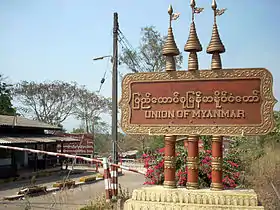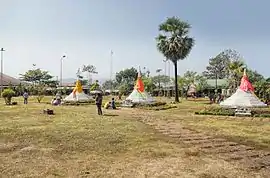Three Pagodas Pass
Three Pagodas Pass (Phlone ကၠံင်သိုင့်ဖၠုံးလါင့်ဆေါတ်ဖိုင်သာ့; Burmese: ဘုရားသုံးဆူ တောင်ကြားလမ်း, Burmese pronunciation: [pʰajá θóʊɰ̃ zù tàʊɰ̃ dʑá láɰ̃]; Thai: ด่านเจดีย์สามองค์, RTGS: Dan Chedi Sam Ong, Thai pronunciation: [dàːn tɕeːdiː sǎːm ʔoŋ]) is a pass in the Tenasserim Hills on the border between Thailand and Myanmar (Burma), at an elevation of 282 metres (925 ft). The pass links the town of Sangkhla Buri in the north of Kanchanaburi Province, Thailand, to the town of Payathonsu in the south of Kayin State, Myanmar.
| Three Pagodas Pass | |
|---|---|
 Myanmar–Thailand border checkpoint at Three Pagodas Pass. | |
| Elevation | 282 m (925 ft)[1] |
| Location | Myanmar–Thailand border |
| Range | Tenasserim Hills |
| Coordinates | 15°18′6″N 98°24′7″E |
 Three Pagodas Pass Location of the Three Pagodas Pass in Thailand, on the border with Myanmar. | |

Etymology
The pass is named after three small, crumbling stupas or chedis which were probably built at the end of Ayutthaya period as a symbol of peace. They are now on the Thai side of the border. Parts of the border are still disputed.[2] These three chedis appear in the provincial seal of Kanchanaburi Province in stylized form.[3] The pass gives its name to the Three Pagodas Fault.
History
The pass has been the main land route into western Thailand since ancient times, and is believed be the point at which Buddhist teachings reached the country from India in the 3rd century.
During the Ayutthaya period in Thai history (14th–18th centuries), the pass was the main invasion route for the Burmese, but at times was also used against them by Siamese armies. The first Burmese invasion through the pass occurred in 1548 during the Burmese–Siamese War (1547–1549).[4]:15–16
During World War II, Japan built the infamous Death Railway (officially Taimen – Rensetsu Tetsudo) through the pass. There is a memorial to commemorate the thousands of Australian prisoners of war who (with other Allied prisoners and Asian civilians) died as forced labourers in the construction of the railway.
The region is home to several hill tribes, including Karens and Mons, who are unable or unwilling to obtain citizenship from either country. Separatist armies have repeatedly tried to take seize of the pass from Myanmar, with the Mons in effective control until 1990, when Burmese troops regained it.
Tourism
Three Pagodas Pass is popular with tourists, who are allowed to obtain a one-day visa from the Thai side to visit Payathonsu. Attractions on the Burmese side include wooden furniture, jade carvings, and textiles. Thai tourists are allowed in as of 2011, while other tourists are not, due to its status as a temporary border checkpoint which only allows day trips between the two neighbouring countries.[5][6]
Festivals
With the rambling strutting roosters of the Buddhist temple of Wat Suwankhiri[7] on a Payathonsu cliff near by, during April, Three Pagodas Pass becomes a site of the Songkran Festival with cockfights, Thai-Burmese kickboxing and various folk dancing.[8]
References
- Three Pagodas Pass, Encyclopædia Britannica
- Thailand Highlight
- Seals of The Provinces of Thailand
- Rajanubhab, D., 2001, Our Wars With the Burmese, Bangkok: White Lotus Co. Ltd., ISBN 9747534584
- List of Temporary and Permanent Border Checkpoint in Thailand, Foreign Affairs Division Office of the Permanent Secretary for Interior (Thai)
- Senator Committee on Temporary and Permanent Boundary Checkpoints
- Lonely Planet Thailand - Wat Suwankhiri
- Lonely Planet Thailand (8th ed) by Joe Cummings (Aug 1999) p.380
External links
 Media related to Three Pagodas Pass at Wikimedia Commons
Media related to Three Pagodas Pass at Wikimedia Commons Three Pagodas Pass travel guide from Wikivoyage
Three Pagodas Pass travel guide from Wikivoyage- Thailand By Train: Kanchanaburi and the River Kwai
- Thailand Travel Guide for Kanchanaburi